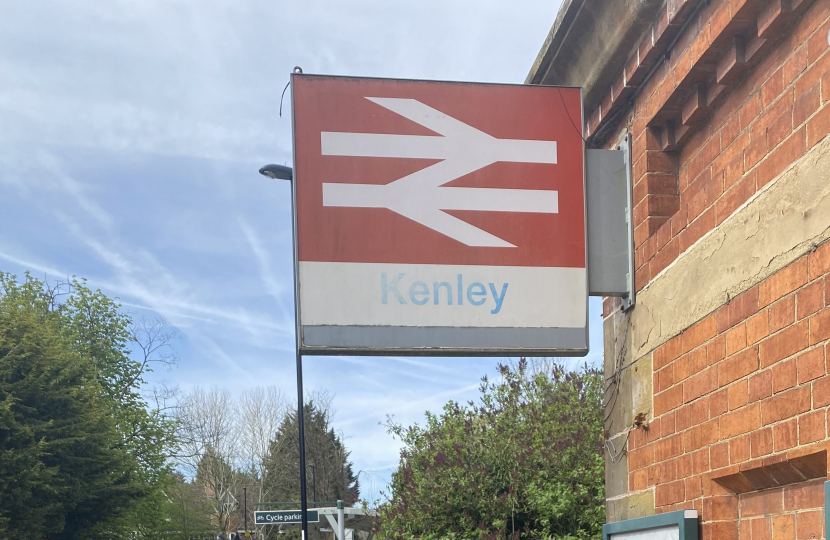
Kenley Councillors have been working with our GLA Member, Neil Garratt to understand why Southern train services on the Caterham line have been reduced.
Neil has had the following response from the train operator which we wanted to share with residents. As a next step we will work with councillor colleagues in neighbouring Tandridge Council, such as Cllr Taylor Driscoll, to meet with the train operator.
Response from the train operator:
“The context to the changes from the 4th September (and the earlier May timetable) is in response to the financial impact of increased working from home. While demand has recovered somewhat, it has stabilised, with peak time demand in the high 60%’s and within that, concentrated Tuesday to Thursday. What we are seeking to do is provide as much peak time capacity in the busiest sections of the network as we can with the resources available.
Similar to the position facing TfL, for a predominantly commuter network like this, relative to the pre-covid service, it means a gap in the region of £350 to £450 million per annum before inflation. As a result, we are having to make some very difficult choices and one of these is to reduce overlap, either directly with our services or with London Overground and TfL bus services.
Monday-Saturday, Caterham currently has four trains per hour, although in practice – the grouping means that it is not an even distribution, with two trains within ten minutes, then a twenty minute gap. Two trains per hour to London Bridge are fast from East Croydon, and two take the slower route via Tulse Hill. Much of the route is also in relatively close proximity to the East Grinstead line with direct services to London Victoria. The grouping of the services, the population density, proximity to other routes, means that as you would expect, it is the fast services, rather than the slower via Tulse Hill services which carry the passenger numbers. Fast services depart Caterham at XX:20/XX:50, via Tulse Hill services at XX:30/XX:00 past the hour.
As something that may be of interest, our timetable information pages update with average loadings from the sensors on our trains, with a colour coding – any shade of green indicates that at least 40% of seats are unfilled, with dark green representing at least 60% of seats available. On the busiest day of the week, Wednesday – there is one peak AM train on the “via Tulse Hill” route, the 07:30 that is not solid green before Purley. The slow service which follows at 08:00 is green. https://timetables.southernrailway.com/SN/#/timetables/1193/Table%20L
This is consistent with the pre-covid position, although of course, the position has been significantly exacerbated by the reduction in usage generally.
The change from the 4th September is to leave the fast London Bridge services in-situ, with the slower via Tulse Hill services terminating at East Croydon – i.e. still running in the busier section between London Bridge, Tulse Hill and East Croydon. This does mean that residents will need to change at East Croydon to access Tulse Hill, but should not have a large impact on journeys to London Bridge as this route is not generally used for that purpose given the longer journey time and the proximity to the fast service. We are making a wider change that it is worth being aware of – the services will call additionally at Norwood Junction, this will provide direct access to London Overground services and on Sundays, the service will now be fast from Norwood Junction, replacing the current all-stations via Sydenham – creating a much faster journey time, and we hope, boosting demand.
While the Norwood Junction stop will result in additional patronage from Norwood Junction customers, the purpose of the stop is to connect the Caterham route with London Overground, and to connect East Croydon with London Overground, rather than Norwood Junction to London Bridge journeys per-se – these will of course happen, but Thameslink accommodates the majority of this use case at present.
With regards to the future, either in terms of running a higher frequency service to London Bridge at peak, or direct to London Victoria - we would need to develop a successful business case for funding including the lease of additional trains. This would need to show that the service is needed to either address significant overcrowding to the point where customers are at risk of being left behind at stations, or will be beneficial to the funding of the wider railway by bringing in additional revenue. At the moment it is not realistic as a case, but clearly as passenger demand changes in the future and if the trend to working from home changes then it is something we will review and will look to work with stakeholders such as yourself to build support.
There is more generally, a demand gap facing public transport and as Caterham itself unfortunately shows, relatively high frequency train services supported by the TfL bus network and Oyster fare structure is not enough to get people using public transport. More action is needed on the private car and we are supportive of measures to encourage people to leave the car at home.”




